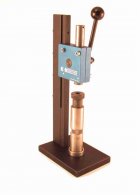damoncali said:
All these glowing recommendations for the Coax have me rethinking them. But I still don't see it. Why spend double on a press that does the same thing as a Rock Chucker (or a Partner for that matter). As far as I can tell, the benefits are:
Better primer disposal
no need for a shell holder
faster die changes
But that shell holder thing looks like an unnecessary pain, and the die swapping saves a whopping 20 seconds. Neither unit has a priming system worth a damn. As far as I can see, all you're paying for is all that extra metal needed to make their design work. Meanwhile, my Rock Chucker is as straight as I can measure, and produces ammo with virtually no runout. Now, there is a difference in the way the handles operate - and I'm not sure which I'd like better, but I've never really had any complaints about the normal style.
Convert a non-believer. Why are these Coax presses such a great thing? What am I missing?
Damon,
Good to see you on another board. I hate to call you out but I am sure you already own a Forster Co-Ax, especially since you sell them at Bison.
But I will play, because you are a good guy and I like you and Frederic.
The biggest advantage of the Forster Co-Ax is the reduction in run-out. The shell plate jaws under spring tension and the floating die allow the die and the cartridge to line up concentrically and this reduces the runout problems that a lot of other presses have. My friend, a sponsored shooter, recently switched from a RCBS to a Forster Co-Ax because his run-out was .004-.006. After switching to the Co-Ax, he realized run-out at .001 to .002. This was simply from changing the press, nothing else.
Bottom line, if you want more accurate ammunition, going with the Forster Co-Ax is the way to go.











